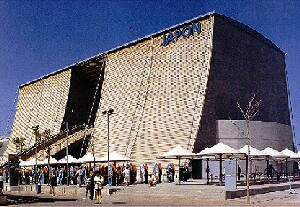|
1 2 3 4 |
 Copyright: |
While arguably the city of Seville - with its redesigned infrastructure, new airport building and new Santa Justa station - was considered by some as a "pavilion" in its entirety, the Spanish Nation itself erected the largest building at the exposition, to a design of Julio Cano Lasso. It was located on the Lago de España, next to the pavilions erected by Spain's autonomous regions, grouped around the lake. The renovated monastery was to be temporary residence to the King of Spain, reiterating the historical importance of the city. To this end an exhibition illustrating the story of the renovation was set up in the centre of the monastery.
Although the EXPO in Seville followed its immediate forerunners in that it did not build a single classic architectural "landmark" building, there were four major pavilions which brilliantly encapsulated the keynote idea of the exposition. The spiritual centre of the exposition site was created by pavilions housing attractive exhibits illustrating: Discovery; The 15th Century; The Present; and The Future.
The professional visitors were perhaps most impressed by the Japanese contribution. Designated the "largest wooden building in the world", the design by Tadao Ando undoubtedly represented the highlight of EXPO ‘92. The mainly wooden building - only the fibre-reinforced concrete foundations and the side walls were not of wood - recalled Japan's traditional building method. The flowing, pagoda-like form of the four storey pavilion featured concave and completely unbroken laminboard facades, with the exception of a single bridge arch, constructed without a base, on the front side.
This evocation of traditional Japanese values also determined the choice of exhibits. Sculptures of Gods, script characters and ancient knight costumes marked the path to the discovery of the "simple culture of the true Japan". This contemplative atmosphere was completely contrasted by a gigantic CCTV screen installed by Sony at the other end of the building which acted as mirror of the goings-on in front of the screen.
Another aspect which reflected the temporary nature of the exposition while simultaneously recapturing the flair of the traditional Toldos - the famous "sun sails" which protect the avenues in Seville from the direct glare of the sun - were the sailcloth sunshades. They gave the pavilion building a light, floating roof and acted as the building's northern and southern sides. Adjustable louvers turned with the sun to ensure the best shade throughout the day. This highly successful project, aimed at providing an oasis in the heat of the sun using sophisticated architectural design, was what made the British pavilion a highlight, rather than the exhibits within, which were presented as if in a department store.
Chile decided to present neither advanced technology, nor to paraphrase the exposition by demonstrating its architectural prowess but instead concentrated on an event which itself became the focus of media attention for several weeks. An iceberg was towed from the Antarctic to Seville to represent "nature" in Chile. Together with an impressively delicate wooden pavilion with a flat copper roof, which employed blinds and skylights to filter the light for the generous interior, this spot became a favourite place for visitors to withdraw from the hustle and bustle.
T
| Year: 1992 | City: Sevilla | Country: Spain |
| Duration: 20th April - 12th October 1992 | ||